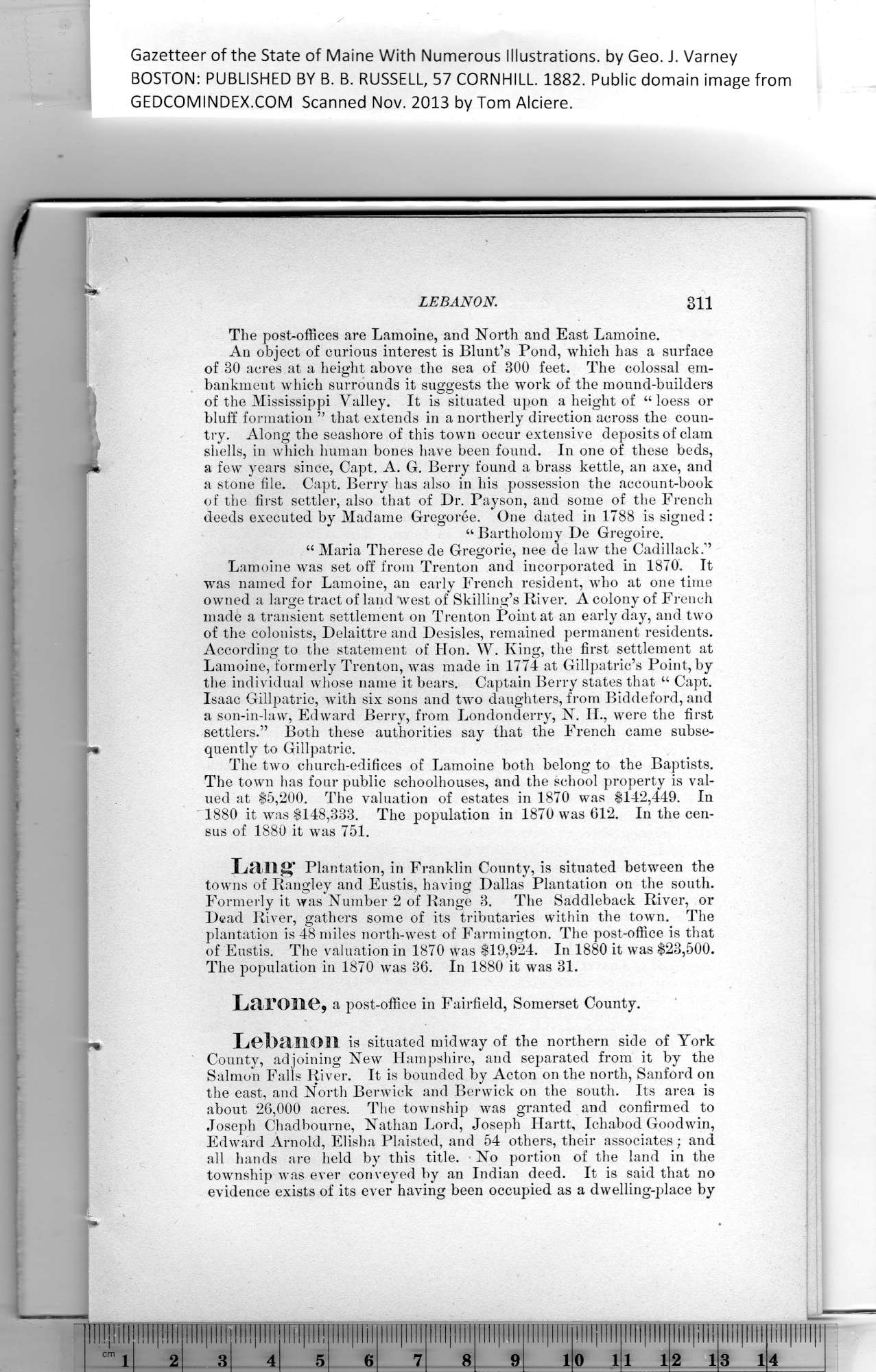|
Gazetteer of the State of Maine With Numerous Illustrations, by Geo. J. Varney
BOSTON: PUBLISHED BY B. B. RUSSELL, 57 CORNHILL. 1882. Public domain image from
LEBANON 311
The post-offices are Lamoine, and North and East Lamoine.
An object of curious interest is Blunt’s Pond, which has a surface
of 30 acres at a height above the sea of 300 feet. The colossal em-
bankment which surrounds it suggests the work of the mound-builders
of the Mississippi Valley. It is situated upon a height of “loess or
bluff formation ” that extends in a northerly direction across the coun-
try. Along the seashore of this town occur extensive deposits of clam
shells, in which human bones have been found. In one of these beds,
a few years since, Capt. A. G. Berry found a brass kettle, an axe, and
a stone file. Capt. Berry has also in his possession the account-book
of the first settler, also that of Dr. Payson, and some of the French
deeds executed by Madame Gregoree. One dated in 1788 is signed :
“ Bartholomy De Gregoire.
“ Maria Therese de Gregorie, nee de law the Cadillack.”
Lamoine was set off from Trenton and incorporated in 1870. It
was named for Lamoine, an early French resident, who at one time
owned a large tract of land west of Skilling’s River. A colony of French
made a transient settlement on Trenton Point at an early day, and two
of the colonists, Delaittre and Desisles, remained permanent residents.
According to the statement of Hon. W. King, the first settlement at
Lamoine, formerly Trenton, was made in 1774 at Gillpatric’s Point, by
the individual whose name it bears. Captain Berry states that “ Capt.
Isaac Gillpatric, with six sons and two daughters, from Biddeford, and
a son-in-law, Edward Berry, from Londonderry, N. H., were the first
settlers.” Both these authorities say that the French came subse-
quently to Gillpatric.
The two church-edifices of Lamoine both belong to the Baptists.
The town has four public schoolhouses, and the school property is val-
ued at $5,200. The valuation of estates in 1870 was $142,449. In
1880 it was $148,333. The population in 1870 was 612. In the cen-
sus of 1880 it was 751.
Lang’ Plantation, in Franklin County, is situated between the
towns of Rangley and Eustis, having Dallas Plantation on the south.
Formerly it was Number 2 of Range 3. The Saddleback River, or
Dead River, gathers some of its tributaries within the town. The
plantation is 48 miles north-west of Farmington. The post-office is that
of Eustis. The valuation in 1870 was $19,924. In 1880 it was $23,500.
The population in 1870 was 36. In 1880 it was 31.
Larone, a post-office in Fairfield, Somerset County.
Lebanon is situated midway of the northern side of York
County, adjoining New Hampshire, and separated from it by the
Salmon Falls River. It is bounded by Acton on the north, Sanford on
the east, and North Berwick and Berwick on the south. Its area is
about 26,000 acres. The township was granted and confirmed to
Joseph Chadbourne, Nathan Lord, Joseph Hartt, Ichabod Goodwin,
Edward Arnold, Elisha Plaisted, and 54 others, their associates; and
all hands are held by this title. No portion of the land in the
township was ever conveyed hy an Indian deed. It is said that no
evidence exists of its ever having been occupied as a dwelling-place by
PREVIOUS PAGE ... NEXT PAGE
This page was written in HTML using a program written in Python 3.2
|
